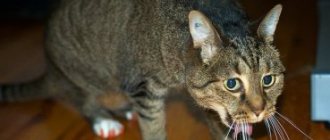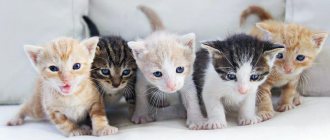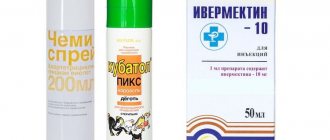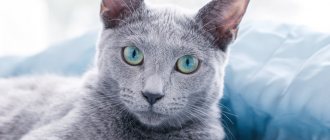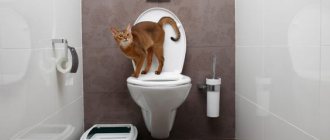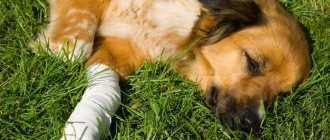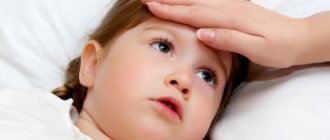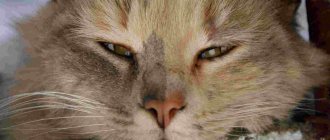Among the many manifestations of your pets’ diseases, it is important to notice dangerous ones and those that are not worth your concern and an unscheduled visit to the veterinarian. This article is devoted precisely to this topic. We will look at the reasons for a cat vomiting after eating food and find out in which case you should sound the alarm.
Prolonged vomiting can lead to dire consequences
Vomiting, its causes and dangers
One of the main dangers of your cat vomiting (food, bile, etc.) is dehydration. If you ignore such an ailment for a long time, it can lead to the death of your pet. However, not every attack of nausea serves as a warning about problems in the functioning of the stomach. Bouts of vomiting every three to four days are considered normal and simply help the animal empty its stomach. Also, there is no need to rush to change the food, because the reason may not be in it at all.
Differences between vomiting and regurgitation
Regurgitation is not a cause for concern, but a reason to monitor the animal’s nutrition
Vomiting can pose a danger to the body. As a result of this unpleasant process, the cat spews out a sour-smelling mass that looks like puree. If an animal regurgitates leftover food, the pieces come out mostly intact. At the same time, they are covered with mucus and have the smell of food.
Danger of vomiting
Dehydration is a dangerous companion to vomiting
As we have already said, dehydration is a dangerous companion to vomiting. However, vomiting can mean many other dangers for your pet. For example, this process may be a sign of infectious and inflammatory diseases, as well as poisoning and injury. If your cat vomits food, but you see blood and mucus in the vomit, and it also has a strange color or foul odor, the situation requires immediate veterinary intervention.
Symptoms of vomiting
You can tell by their behavior that your cat is vomiting.
By carefully observing your pet, you can easily determine that the cat is about to vomit. At first, you can notice signs of anxiety in her behavior. The animal begins to move from place to place, and copious amounts of saliva are observed. The cat then makes swallowing movements, which turns into a cough. The pet begins to breathe deeply and frequently. Simultaneously with contractions in the abdomen and pharynx, the animal begins to stretch its head forward, and vomiting is observed. The first few coughs do not bring any results, and then the pet dumps the contents of its stomach on the floor.
What could be the causes of vomiting?
The causes of illness are varied
The answer to why your cat is regurgitating food could be due to many reasons. Therefore, before you take action, it is important to make sure that you have identified them correctly. There may be several reasons:
- Binge eating;
- Feed;
- Diseases of the gastrointestinal tract;
- Helminths;
- Sterilization or castration;
- Infection;
- Changes in diet;
- Pregnancy.
Mistakes when organizing feeding
The mistake is made by owners who prefer only one type of food. A cat needs variety in its diet (for example, if your pet only eats dry food, you should sometimes give it wet food as a treat, and vice versa). However, it is important to remember that human food is not always suitable for them and can even be poisonous. These are, for example, tomatoes and eggplants. They should also not eat food that contains less than twenty-five to thirty percent meat. Often, even premium food contains ingredients that are basically unsuitable for pet food (eggs with shells, poultry bones, etc.). If you are just about to choose food, you can choose one pack of each manufacturer (or a hundred grams if the food is sold by weight) and monitor your pet’s reaction.
It is necessary to protect your pet from low-quality food
The mistake may also lie in the portions that the owners dump in front of the pet. It is important to follow the dosage recommended by the manufacturer. Although the food seems quite light, in the moist environment of the stomach it swells and can cause vomiting. Many cats tend to eat as much as they see and cannot control themselves, so it is up to the owner to do this.
Watch your portion sizes
It also happens that the owner adheres to the specified portion sizes, but the cat eats too quickly, which leads to the animal vomiting food. Such cases are typical for families with several animals and for those pets who previously experienced a lack of food. To help your cat get rid of this haste, you can feed it separately from other pets, use a bowl with ridges designed to slow down the absorption of food, or simply feed the cat more often, but in small portions.
Rushing to eat due to fear of hunger
Vomiting can also be caused by too sudden changes in food. A new one should be introduced into your pet’s diet gradually, mixing it with the old one over a period of one to two weeks. This will help your cat's enzymatic system adjust painlessly.
Feed changes should occur gradually
A cat may vomit dry food because it has spoiled or its expiration date has expired. Signs of this include mold and a rancid or sour odor from the pellets. If the expiration dates are in order, it means that the storage conditions have spoiled the food (in a too warm or humid room, in an open bag or in the light). Therefore, when purchasing food (preferably not in bulk), it is important to pay attention not only to the expiration date, but also to the integrity of the packaging. Also, if you have only one pet, you should not purchase too large a package of food, since during the recommended shelf life (three months after opening) the animal may not have time to eat the entire package.
Monitor the quality of the feed
Also, the food may simply not be suitable for your pet. Often the problem is not with the whole food, but with one of its components (protein source). A sign that a cat has a food intolerance is a problem with the animal's stool.
Correct selection of food is an important point in feeding
Vomiting can also be caused by mixing dry food with natural products. The fact is that the digestion of these two components requires an environment of different acidity and different periods of time. As a result of the collision of these different “interests,” the digestive process stops. Food lingers in the stomach, and he, in turn, regards this food as a threat and rushes to remove it from the body as quickly as possible.
Dry food may not be to blame
The cause of vomiting is not necessarily the food. A very common culprit of nausea is hairballs that accumulate in a cat's stomach after licking. It is after eating that they often leave the body, as the stomach fills with food and gets rid of the foreign object that interferes with digestion. To relieve your cat from unpleasant sensations, special malt pastes are used to dissolve hairballs. You can purchase them at veterinary pharmacies and pet stores.
Fur often accumulates in a cat's stomach.
Another reason not related to food is helminths. Prevention is necessary quarterly. If you have subjected your animal to this procedure for a long time, the vomiting is probably caused by parasites that have settled not only in the intestines, but also in the esophagus and other organs. If the case of damage is severe, you should not treat it yourself. The specialist will develop a treatment program in which the parasites will be destroyed without harming the cat as a result of intoxication.
How to feed a cat correctly
A pet will not drink vitamins if they are lacking, so all the vitamins and minerals it needs must be present in the food. The animal needs balanced food. How to feed your furry friend correctly, how to make sure that the animal receives with food everything it needs for proper development and good health?
- First, the amount of food should be limited. You need to feed the animal 2-3 times, in the morning and in the evening, but you can skip lunch. Portions should be approximately the same size each time. It is better to put in less food and then add it later, rather than the animal overeating and becoming ill.
- Secondly, the food must be of high quality. High quality does not mean expensive. You can boil the animal’s meat yourself, adding carrots and other vegetables. If you don’t want to cook separately for your cat, then you should contact your veterinarian for advice; he will be able to tell you exactly what food is suitable for a particular breed.
- Thirdly, the water in the bowl must be clean. You need to change and add water at least twice a day, it is better to do this in the morning and evening. Your furry friend should always have water. There is no need to experiment and pour mineral water with gases into your cat. The cat will not drink water, and he will have to sit without water all day, which is fraught with negative consequences for his body.
- Fourthly, a four-legged friend needs grass. You can buy seeds for such grass at any pet store; it is inexpensive, grows quickly, and looks like a lawn. Cats love this simple green grass.
- Fifthly, your pet’s diet must include fish. Fish contains useful microelements that a cat needs as a predator.
- Sixth, if a favorite predator eats what its owner eats (some cats love apples, cucumbers and other foods), there is no need to wean him off. This means that the beneficial substances contained in these products are necessary for the predator.
Creating the right diet for a cat is not difficult. The main thing is to monitor your pet’s well-being, carefully read the composition of the food he eats, listen to the veterinarian’s recommendations and add variety to your pet’s diet.
What diseases can there be
Only a doctor can make an accurate diagnosis
Vomiting after eating can be caused by diseases such as gastritis, colitis, poisoning, intestinal pathologies (obstruction, tumors, unstable blood supply), ulcers, pancreatitis and, as we wrote above, helminths. A doctor will be able to make an accurate diagnosis based on the results of a gastrointestinal ultrasound and tests performed.
What symptoms require you to go to the clinic?
Don't hesitate to visit a doctor
If a cat vomits more than three times a day (or several days in a row), and at the same time it looks lethargic, weak and refuses food, this is a signal that it is necessary to seek professional help. Other alarming symptoms are impurities in the vomit that are not food debris (especially if it is blood), vomiting regardless of whether the cat has just eaten or not, as well as accompanying symptoms such as changes in temperature, weakness, diarrhea, watery eyes, tremor and others.
What to do if your cat vomits undigested food
There are three reasons why a pet vomits whole food after eating:
- The animal simply overate. In this regard, recommendations have already been given above - reduce portions. If there are several cats living in a house, then they live in conditions of competition, and regarding food too. In a large cat family, the task of each member is to eat more, in case there isn’t enough.
- Low quality food. A cat is a predator; its body, due to its structure, constantly needs protein, that is, meat. Therefore, meat must be present in the diet; cats do not have specific preferences: rabbit, turkey, pork, they will happily eat any meat.
- Poisoning. Just like the human body, the body of your furry friend will try to get rid of bad food as quickly as possible. Typically, vomiting in case of poisoning is also accompanied by diarrhea. It is not difficult for even inexperienced owners to detect poisoning in an animal. It is better to consult a veterinarian for treatment.
If, after the portions have been reduced and the food has been changed, the four-legged friend continues to vomit, then the owner should immediately consult a doctor.
What to do at home
A trip to the veterinarian should not be put off, however, if you are unable to take your pet to the doctor promptly, you can alleviate its condition yourself. Help lies in the fact that the animal must be limited in food and drink if it still has a craving for food. You need to feed your pet small pieces every two hours and only easily digestible foods, such as baby food, cottage cheese or boiled chicken. Water can also be given only in small portions.
Be sure to replenish your pet's body fluids
The following medications are also used as prescribed by a doctor:
- Injection of Ringer-Locke solution (used if the animal refuses to drink and take medications for dehydration);
- Phenothiazine and Paspertine (antiemetic drugs used for prolonged vomiting);
- Bismuth preparations (protect the mucous membrane of the digestive tract from irritating factors);
- Activated carbon, enterosgel and a dropper with glucose (help with poisoning, but it is better to do the dropper in a veterinary clinic);
- Antibiotics (prescribed by a doctor in severe cases caused by infection or damage to the stomach lining).
Once problems with digestive system dysfunction or intoxication are resolved, the cat will need a long recovery period. For several weeks, feeding should be frequent, small portions, light, crushed food. Meat and food based on it should be introduced into the diet gradually. In rare cases, the diet needs to be followed for several years or even a lifetime.
What to do if your cat vomits from any food
The first cause of vomiting in a furry friend is unsuitable food. This rarely happens; usually the animal itself refuses to eat this or that food. By smell, these domestic predators determine whether the food is of low quality and whether what is in the bowl is worth eating. If the owner has already tried all the food, but the situation has not changed, then the problem is not in the food. There are two options: the animal simply overate, or got sick. The first option is easier to deal with. To prevent the animal from overeating, it is important to feed a strictly defined amount of food, without exceeding the volume.
Animals have almost no feeling of satiety. Cats are no exception; they will eat until their bowl is empty, and then vomit up undigested food and cover it with a rug. If your cat gets sick after eating food, you just need to give her more water and reduce the portion.
As for the second option – disease, things are more complicated. Simply reducing portions will not correct the situation. It is better not to diagnose the animal’s condition yourself, but to consult a veterinarian.
